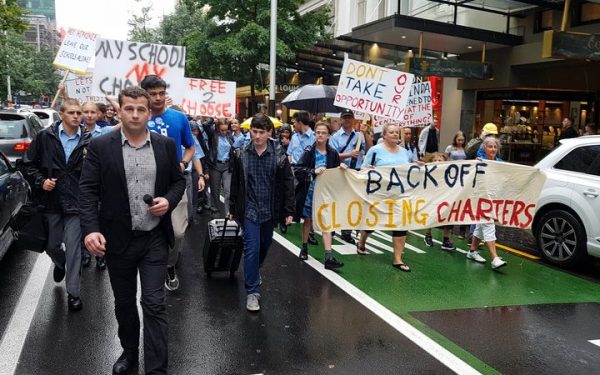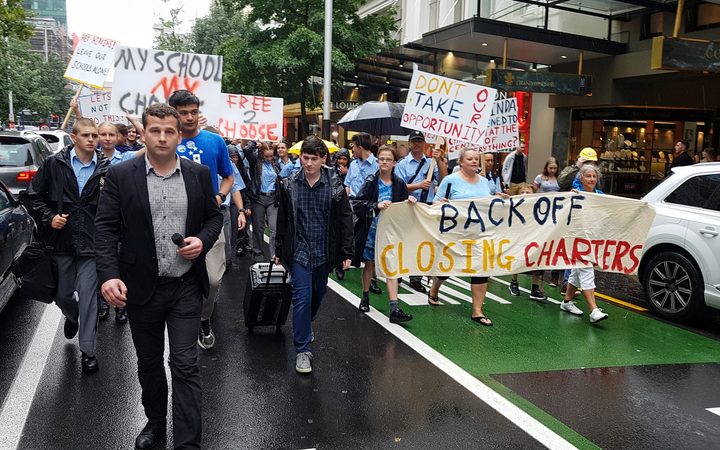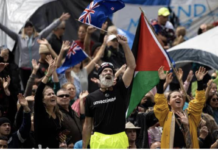
Who is Mike Feinberg?
Mike Feinberg is the co-founder of KIPP and is a board member of the KIPP Foundation.
What is KIPP?
KIPP stands for “Knowledge is Power Programme” and uses a “no excuses” philosophy to run 125 Charter schools across the US enrolling nearly 40,000 students mainly from low-income communities.
Why was KIPP founded?
Feinberg claims public education is failing poor children in the US and says poverty is no excuse. This was music to the ears of right-wing foundations and corporate capitalists who have donated tens of millions to establish KIPP schools as well as promote the idea that the private sector should take over public education.
What is he doing in New Zealand?
He’s here to promote the Act/National government’s charter schools policy and encourage the privatisation of public education.
Who paid for him to come here?
His visit has been funded by the Aotearoa Foundation which is the local arm of the right wing USA-based Robertson Foundation. Aotearoa Foundation and the Robertson Foundation were established by American Hedge Fund billionaire and honorary New Zealand knight Julian Robertson. The Robertson Foundation is now headed by former Auckland and Oxford University vice-chancellor, John Hood. Hood is also a trustee of the Aotearoa Foundation.
The Robertson Foundation is one of the new breed of so-called ‘philanthrocapitalists’, private sector investment funds and trusts that view charity not as altruistic giving, but as just another business investment opportunity to influence government policy and the delivery of public education. And, to do so by lobbying behind closed doors, completely outside the democratic process.
Are KIPP schools successful?
At a superficial level the school results look good but behind the gloss the figures make grim reading. KIPP claims for example that 80% of the children who complete the 8th grade (Year 9) in a KIPP school go on to University compared to just 20% of children from public schools. This is highly misleading at best because the dropout rate from KIPP schools is very high particularly before Grade 8 (Year 9) Overall 30% of students drop out before Grade 8 but the figure becomes an astonishing 40% for African American males. The comparable dropout rate from public schools of the same demographic is 6%. When these dropout rates are factored in the comparative success of KIPP schools plummets. Some researchers have even suggested the rates of University attendance may be lower at KIPP schools than for the same demographic of public school students.
Why is the dropout rate so high in KIPP schools?
The dropout rate is high because the schools set rigid standards for passing standardised tests and obeying school rules. Children who fail are kept back a year and many leave to return to public schools rather than repeat a year behind their friends. In this way children of lower academic ability are weeded out. Others are expelled or given the US version of a “kiwi-suspension” when they misbehave (where the parents are encouraged to remove their child from the school).
After weeding out the poor performers and those who break their rigid rules the KIPP leaders then bask in the warm glow of the success of those who lasted the distance.
How are KIPP schools funded?
KIPP schools receive much more revenue from all sources (eg including corporate donations) per student than comparable public schools, on average $18,491 per student vs. $11,991 per student in a public school.
How are KIPP schools run?
There is some variation between KIPP schools but basically they run from 7.30am to 5pm each day with a half day on Saturday and three weeks over the summer break.
They focus strongly on teaching numeracy and literacy because these are measured in standardised tests. The schools have a very tight behaviour regime best illustrated in the following anecdote from researcher Howard Berlak after a visit to a KIPP school in San Francisco:
“When I was there children who followed all the rules were given points that could be exchanged for goodies at the school store. Those who resisted the rules or were slackers wore a large sign pinned to their clothes labelled “miscreant.” Miscreants sat apart from the others at all times including lunch, were denied recess and participation in all other school projects and events.
. . . . I’ve spent many years in schools. This one felt like a humane, low security prison or something resembling a locked-down drug rehab program for adolescents run on reward and punishments by well meaning people. Maybe a case can be made for such places, but I cannot imagine anyone (including the Times reporter) sending their kids there unless they have no other acceptable options. What is most disturbing is the apparent universal belief by KIPP staff and partisans that standardized tests scores are the singular and most important measure of a truly good education. “
Similar stories are commonplace. It’s easy to see why the Knowledge is Power programme has been dubbed the Kids in Prison programme.
What are the rules for teachers, students and parents in KIPP schools?
The rules for teachers, parents and children are here:
http://www.kipp.org/files/dmfile/KIPP_Commitment_to_Excellence_Sample.pdf
Teaching and learning is not so much based around good relationships between teachers and students as it is based on sets of rules to be followed.
Who teaches in these schools?
The teachers are predominantly young and less experienced. Many are “graduates” of the “Teach for America” programme which fast-tracks teacher education. The dropout rate of teachers is very high – typically they leave after two years – because they work unsustainably long hours (up to 70-80 hours per week is common) on relatively low pay.
Note: The Robertson Foundation (see above) is a funder and supporter of the US programme “Teach for America” which feeds teachers into charter schools. Here in New Zealand Julian Robertson has also been associated with the establishment of the equally controversial Teach First New Zealand fast-track six-week teacher training scheme at Auckland University. A scoping study for Teach First New Zealand was jointly funded in 2010 by the Aotearoa Foundation and The Warehouse founder Stephen Tindall’s Tindall Foundation. It seems clear that Teach First New Zealand has been specifically set up to feed unregistered green “teachers” into charter schools here.
Should New Zealanders be worried?
Absolutely. This is an all out attack on public education. Once charter schools are established they will be promoted heavily by the right wing just as they have been in the US and public education with become fragmented and incoherent as it has become in the US, UK and Australia.
But couldn’t charter schools improve education for children in low-income communities?
Charter schools have been around for 20 years and there is no reliable data to conclude they do better than public schools in any country (see earlier comments re KIPP schools) for children from low-income communities. Promoters of charter schools invariably produce data to support a claim of better education but these generally founder under independent assessment.
Earlier this year Massey University Policy Response Group did a comprehensive analysis of charter schools in the UK, USA and Sweden. Their report can be read in full under the “Research on Charter Schools” tab at www.qpec.org.nz
How good is New Zealand’s public education system?
The New Zealand public education system is excellent. Our state school students regularly top students anywhere in the world. In the most recent PISA (Programme for International Student Assessment) results for 15 year olds New Zealand was ranked fourth out of 34 OECD countries in reading literacy, fourth in scientific literacy, and seventh in mathematical literacy. Our kids are world beaters, our teachers are stunning and our public schools are outstanding.
By comparison the US, UK and Sweden (all quoted favourably by Act/National) have much weaker results because they have allowed the private sector through charter schools to fragment their education delivery.
What about our “long tail of underachievement”?
This is a huge cause for concern but the problem is not underperforming public schools, useless principals or hopeless teachers as Feinberg, Act and National would have us believe. Instead it’s primarily the economic policies which have grown the gap between rich and poor faster in New Zealand than any other OECD country in the past 27 years. Whenever this gap widens then social problems proliferate and education underachievement becomes endemic in low-income areas. For example public schools are NOT to blame when:
- Kids arrive at school too hungry to learn
- When children change school frequently as a result of poverty (transience)
- Classes are too large to enable close learning relationships to develop between teachers and students
What should New Zealand be doing about the fact so many children, disproportionately Maori and Pacifika, are leaving school without even a level one NCEA qualification?
Outside of schools we need to push for government policies which take the financial burden off low-income families; feed our kids breakfast and lunch in schools each day; ensure families have warm, dry homes which are not overcrowded and kids don’t contract third world diseases. We should be also be pushing for families to have decent incomes so kids aren’t shuffled between parents, grandparents and other relations so that every Monday morning in South Auckland the equivalent of an entire primary school of children change schools. How can these kids in “transience” ever benefit from what a high quality school can offer?
Inside schools we need to increase resourcing for programmes shown to make a significant difference for Maori and Pacifika children (such as the Kotahitanga programme and the AIMHI initiatives) We also need resources to dramatically reduce class sizes in schools in our low-income communities so teacher/student relationships can be strengthened where the need to do so is greatest.
Some worthwhile references on charter schools and KIPP:
http://www.stuff.co.nz/manawatu-standard/features/7564142/Finnish-lessons-No-charter-school
http://www.schoolsmatter.info/2012/09/a-former-kipp-teacher-shares-her-story.html
http://www.schoolsmatter.info/2010/11/learning-about-kipp-lesson-1.html
http://www.schoolsmatter.info/2010/11/learning-about-kipp-lesson-2-kipp.html
http://www.schoolsmatter.info/2010/11/learning-about-kipp-lesson-3-social.html






I studied last years NCEA results and I noticed the total immersion Maori schools are right up there with many of NZs private colleges. Maori have tried for many years to have more control over their own education systems . Which is why some Maori embrace the charter model but the model is flawed you cant have different levels of accountability or teachers with no qualifications and the schools should not be established primarily for profit there main objective is for all their students to achieve particularly those who are failing in mainstream. Catholic schools have been allowed to run their own religious based schools so what is wrong with Maori having their own schools as mainstream has failed many for various reasons.
Comments are closed.